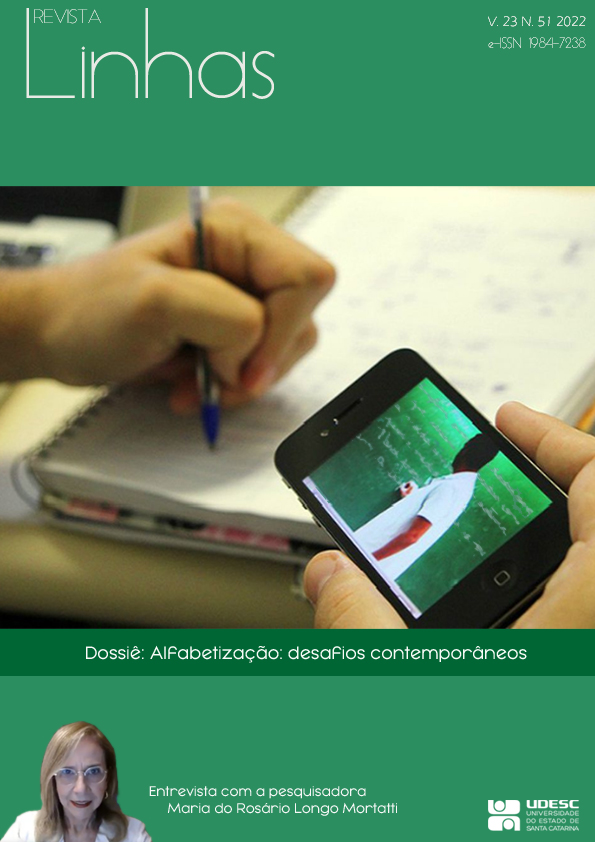Arte y educación: concebir el espacio del atelier como una oportunidad de innovación didáctica
DOI:
https://doi.org/10.5965/1984723823512022215Palavras-chave:
arte y educación;, innovación didáctica.Resumo
Desde la Licenciatura en Educación Inicial y la Licenciatura en Artes Visuales de la Universidad Católica del Uruguay, se ha implementado un proyecto que busca nutrir a los docentes de elementos incursionar en el espacio del atelier, su diseño, y las herramientas que proporciona, para la innovación didáctica. En América Latina son escasas las formaciones específicas en la adaptación de nuevas pedagogías que involucren recursos artísticos, orientadas hacia el desarrollo de competencias relacionadas con la empatía, la comunicación, la comprensión de su contexto y el respeto por el medio ambiente. Para esta propuesta pedagógica incluimos algunas de las técncias y postulados de la cultura del atelier que se gesta en las Escuelas de Infancia en los inicios de los años 60, en el municipio italiano Reggio Emilia. Son escuelas inspiradas en el enfoque socio-constructivista del conocimiento y la valorización de una multiplicidad de lenguajes expresivos de Loris Malaguzzi (Cavallini et al., 2017). El atelier se configura como un espacio que cristaliza los aprendizajes. En palabras de Vecchi: “la percepción sensorial, el gusto de la seducción, lo que Malaguzzi llamaba la vibración estética, pueden ejercer de catalizadores de un aprendizaje, y cómo pueden apoyar y alimentar un conocimiento que no se nutre solo de información”. Para esta propuesta, nos planteamos tres objetivos específicos: 1) Sensibilizar a los participantes en la deconstrucción de la neutralidad aparente de los objetos cotidianos, para comprender las formas de percepción del sujeto; 2) Reflexionar acerca del postulado hacer es pensar, definido por el filósofo Richard Sennet como la convicción de que todas las habilidades incluso las más abstractas como pensar, deducir, etc., comienzan como prácticas corporales (2013); 3) Ejercitar un rol docente posicionado como guía y facilitador de experiencias.
Downloads
Referências
ARTAUD, A. (2001). El teatro y su doble. Edhasa.
BARTHES, R. (1994). El susurro del lenguaje: más allá de la palabra y de la escritura, trad. C. Fernández Medrano. Paidós.
BLAZHENKOVA, O., & KOZHEVNIKOV, M. (2020). Creative Processes during a Collaborative Drawing Task in Teams of Different Specializations. Creative Education 1, 1751-1775 Available from:
CIVAROLO, M. Coord. (2016). Viaje iniciático al pensamiento de Loris Malaguzzi, Universidad Nacional de Villa María.
CIVAROLO, M. y PÉREZ ANDRADA, M. (2017). El arte de componer un panel de documentación en clase, Nro2. Trazando rumbos: el niño y sus cien lenguajes: módulo de actualización: enfoques Pedagógicos que renovaron la Educación Infantil. El enfoque de Reggio Emilia. Buenos Aires. Ministerio de Educación de la Nación.
GARCÍA PÉREZ, L., GARCÍA GARNICA, M. Y OLMEDO MORENO, E. (2021). Skills for a working future: how to bring about professional success from the educational settings. Educ. Sci., 11, 27. https://doi.org/10.3390/educsci11010027
HAN, N. Ch. (2015). La salvación de lo bello. Herder.
HEIDEGGER, M. (2010) (1era Edición en español 1995), Caminos del bosque, Alianza Editorial.
HOYUELOS, A. (2004). El niño viene al mundo a buscar y a encontrar un significado a ese mundo y a su propia existencia. Aula de infantil.
HOYUELOS, A. (2005). La cualidad del espacio ambiente en la obra pedagógica del Loris Malaguzzi. Grao.
HOYUELOS, A. (2013). La estética en el pensamiento y obra pedagógica de Loris Malaguzzi. Temas de in-fan-cia. Educar de 0 a 6 años. Octaedro.
MARGARIDA ROCHA, A; ALMEIDA, T; MACHADO, G. (2021). The Threshold between the Material and Immaterial Light. Notes on Luminescence and Dark Environments, Arts, pp. 10-56.
OCDE (2019). Habilidades y competencias del siglo XXI para los aprendices del nuevo milenio en los países de la OCDE.
PÁRAMO, P. (2021). El tercer maestro: La dimensión del ambiente educativo y su influencia sobre el aprendizaje. Universidad Pedagógica Nacional.Pérez Tudela, J. (2015). STEM, STEAM... ¿pero eso qué es?. Odite.ciberespiral.org, 21 abril.
SENNET, R. (2009). El artesano. Anagrama.
SERÓN TORRECILLA, F. y MURILLO LIGORRED, V. (2020). Arte contemporáneo y STEAM en la formación de maestros de educación primaria: intersecciones arte y ciencia, AusArt Journal for Research in Art. 8 (1), pp. 65-76, versión online: www.ehu.es/ojs/index.php/ausart
ZECCHETTO, V. (2010). El persistente impulso a resemantizar. Universitas. Revista de Ciencias Sociales y Humanas, Nº 14, 2011, Universidad Politécnica Salesiana del Ecuador.
Downloads
Publicado
Como Citar
Edição
Seção
Licença
Copyright (c) 2022 Revista Linhas

Este trabalho está licenciado sob uma licença Creative Commons Attribution-NonCommercial-NoDerivatives 4.0 International License.
Os artigos publicados pela revista são de uso gratuito, destinados a aplicações educacionais e não comerciais. Os direitos autorais são todos cedidos à revista. Os artigos cujos autores são identificados representam a expressão do ponto de vista de seus autores e não a posição oficial da Revista Linhas ou do Programa de Pós-Graduação em Educação da Universidade do Estado de Santa Catarina.

A Revista Linhas está licenciada com uma Licença Creative Commons - Atribuição-NãoComercial-SemDerivações 4.0 Internacional.


